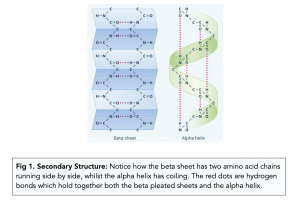Protein Structures: Primary and Secondary Structures (A-level Biology)
Protein Structures: Primary and Secondary Structures
Structure of Proteins
Proteins are fairly large molecules and are extremely complex. To make things simpler, we can describe protein structure in terms of four levels, with each new level building upon the previous level. We will begin with the first two levels: the primary and secondary structures.
Primary Structure
The primary structure of a protein is the sequence of amino acids that make up its polypeptide chains.
Secondary Structure
The primary structure is flat and 2D. Proteins, like other molecules, are 3D objects. Hydrogen bonds between different amino acids in the chain are responsible for the secondary structure.
Hydrogen bonds form between the R groups of amino acids. Hydrogen bonding between the variable “R” groups of amino acid side-chains causes coiling (alpha helices) or folding (beta sheets).
- Alpha (α) helices form due to coiling. Hydrogen bonding leads to coiling, forming a spiral, cylindrical (helical) shape.
- Beta (β) pleated sheets form due to folding. Hydrogen bonding leads to folding, forming an almost flat, but kinked sheet of amino acids. They are formed by two amino acids chains running anti-parallel to each other (see Figure 1).

Primary structure refers to the sequence of amino acids in a protein. It is the most basic level of protein structure and determines the unique characteristics of each protein.
Secondary structure refers to the specific 3D shape that the protein takes due to hydrogen bonding between the amino acids. This structure is crucial for the protein’s function.
The primary structure determines the protein’s unique characteristics and its overall chemical properties, while the secondary structure determines the protein’s 3D shape, which is necessary for its specific function.
There are two main types of secondary protein structures: alpha helices and beta sheets. Alpha helices are spiral-like structures, while beta sheets are flat and often form pleated structures.
The formation of alpha helices and beta sheets helps to stabilize the protein’s structure. The hydrogen bonds between the amino acids help to maintain the shape of the protein, and prevent it from falling apart or denaturing.
If the primary sequence of a protein is altered, it can lead to changes in its secondary and tertiary structures, which can affect its function. In some cases, a change in the primary structure may cause the protein to become denatured and unable to perform its intended function.
The secondary structure of a protein can be determined through various techniques, including X-ray crystallography, NMR spectroscopy, and circular dichroism spectroscopy. These techniques can help to determine the specific 3D shape of the protein and identify the presence of alpha helices and beta sheets.
The tertiary structure refers to the overall 3D shape of a protein and includes all of its structural elements, including the secondary structures and any other elements, such as cofactors or ligands. The tertiary structure is crucial for the protein’s function because it determines the protein’s spatial relationships with other molecules and its ability to bind to specific targets.






Still got a question? Leave a comment
Leave a comment